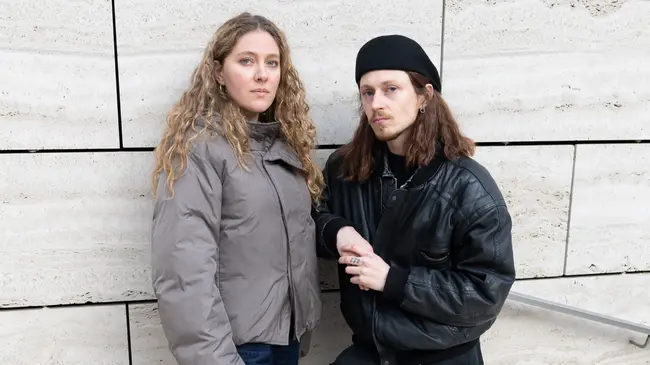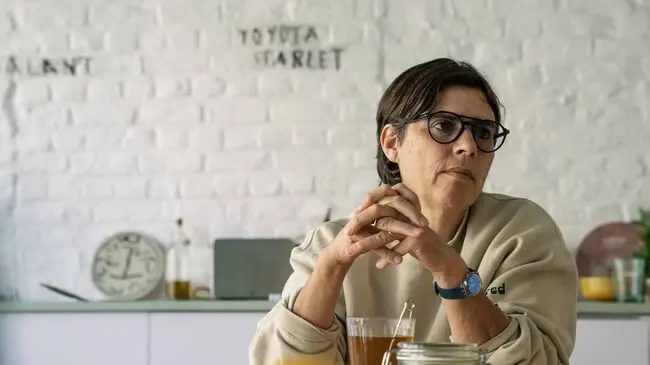What Hath God Wrought?

Connecting, a new group show at K1 Kanal Centre Pompidou, explores the confrontations and symbioses between digital technologies and the embodied reality of the human condition. We spoke to featured artist Eva L’Hoest about her practice and research.
Can you talk about your work for the Connecting group show at Kanal Centre Pompidou?
I created two autonomous works, an online film accompanied by an on-site intervention in the K1 staircase. Both pieces were developed around research on the origins of the underwater cable network through which 99% of what we consume on the Internet today passes. For the online piece, I collaborated with the writer and director James Vaughan, cinematographer Dimitri Zaunders, and composer and flautist John Also Bennett. The whole process was about trying to unearth the undersea network, to give it tangible substance, both through the written narration and a haptic approach to imagery and sound. In a way, the underwater networks suffer from a dual invisibility, both physically and historically, which was the starting point of the writing process. By reading about it, you realise very quickly that the network upholds colonial geographies that still influence the actual networks. This raises reflections on the human body, the maritime labour and the impact of the network on the land that it crosses.
<img class="editorial-image-50-left" src="https://cdn.prod.website-files.com/61eebcc683107b99137f4423/653fbbccc4f780e7e75d6c74_Eva%20L%27Hoest%20(c)%20Lupe%20ArensDifferent%20Class_Eva%20L%27Hoest_15.webp"/>
<img class="editorial-image-50-right" src="https://cdn.prod.website-files.com/61eebcc683107b99137f4423/654125a955e48e6b5ec7670b_differentclassEva%20L%27Hoest%20(c)%20Lupe%20Arensfavo_Different%20Class_Eva%20L%27Hoest_9.webp"/>
The on-site intervention I built through a more sculptural approach reflects these bodily, physical implications of the undersea networks. It’s a braid inspired by Rapunzel’s hair, her only means of contact with the outside world, which carries the visitor’s gaze up the staircase at K1. I was searching for an element that could interact with the space, and upon rediscovering a very old illustration of the tale, I was struck by the strangeness of the composition, the materiality of the hair, its relationship to architecture, communication, and isolation.
This isn’t the first time you have placed the human body at the centre of your work around the imperfections of technology, its accidents and unforeseen implications.
Yes, I am interested in the reification of the human figure through digital processes, the transition from analogue to digital, and how the digital can offer its own perspective on the human condition and our relationship with technology.
I am interested in the reification of the human figure through digital processes and how the digital can offer its own perspective on the human condition
<img class="editorial-image" src="https://cdn.prod.website-files.com/61eebcc683107b99137f4423/653fbbcbfdc3e365991f5f94_Eva%20L%27Hoest%20(c)%20Lupe%20ArensDifferent%20Class_Eva%20L%27Hoest_12.webp"/>
For example, through working with CGI, I discovered different body-scanning cameras from the video game industry. I was struck by how the scans amalgamated the living and the inanimate world, and how it could create new narratives and new ways of looking at the human condition through a technology that was at the time booming into security and surveillance. I also became interested in the glitches and bugs caused by the device, which misinterprets spaces and bodies. I envisioned these glitches as a form of resistance zone between two worlds, extracting elements from the typical fiction assigned to them.
I see glitches as a form of resistance zone between two worlds, extracting elements from the typical fiction assigned to them
<img class="editorial-image-50-left" src="https://cdn.prod.website-files.com/61eebcc683107b99137f4423/653fbbccd262dee0676203c7_Eva%20L%27Hoest%20(c)%20Lupe%20ArensDifferent%20Class_Eva%20L%27Hoest_19.webp"/>
<img class="editorial-image-50-right" src="https://cdn.prod.website-files.com/61eebcc683107b99137f4423/653fbbe45aa5998ecbdc8827_Eva%20L%27Hoest%20(c)%20Lupe%20ArensDifferent%20Class_Eva%20L%27Hoest_17.webp"/>
In parallel with this technical discovery, I was reading about the art of memory, an ancient practice to aid in retaining rhetoric and text through entirely imaginary and proto-virtual spaces. I saw it as a very early form of cinematic practice: if you memorize poetry, you construct a gallery; for an encyclopedia, you build a city, and you create long mental tracking shots, from place to place, attached to a reading voice. While experimenting with the 3D scanner, I wondered how these new ways of externalising the world would change our relationship with our own memory, our emotions, and alter our perception.
Connecting, a group show at K1 Kanal Centre Pompidou explores the confrontations and symbioses between digital technologies and the embodied reality of the human condition. We spoke to featured artist Eva L’Hoest about her practice and research. Can you talk about your work for the Connecting group show at Kanal Centre Pompidou?
I created two autonomous works, an online film accompanied by an on-site intervention in the K1 staircase. Both pieces were developed around research on the origins of the underwater cable network, through which 99% of what we consume on the Internet today passes. For the online piece, I collaborated with the writer and director James Vaughan, cinematographer Dimitri Zaunders and composer and flutist John Also Bennett. The whole process was about trying to unearth the undersea network, to give it tangible substance, both through written narration and a haptic approach to imagery and sound. The underwater networks, in a way, suffer from a dual invisibility, both physically and historically. Which was the starting point of the writing process.
<img class="editorial-image" src="https://cdn.prod.website-files.com/61eebcc683107b99137f4423/653fbbcafb142c389c70a97d_Eva%20L%27Hoest%20(c)%20Lupe%20ArensDifferent%20Class_Eva%20L%27Hoest_21.webp"/>
By reading about it, you realise very quickly that the network upholds colonial geographies that still influence the actual networks. This raises reflections on the human body, the maritime labour and the impact of the network on the land that it crosses. The on-site intervention I built through a more sculptural approach. It reflects these bodily, physical implications of the undersea networks - it’s a braid inspired by Rapunzel’s hair, her only means of contact with the outside world, which carries the visitor’s gaze up the staircase at K1. I was searching for an element that could interact with the space and upon rediscovering a very old illustration of the tale, I was struck by the strangeness of the composition, the materiality of the hair, its relationship to architecture, communication and isolation.
This isn’t the first time you have placed the human body at the centre of your work around the imperfections of technology, its accidents and unforeseen implications.
Yes, I am interested in the reification of the human figure through digital processes. The transition from analogue to digital, how the digital can offer its own perspective on the human condition and our relationship with technology. For example, through working with CGI, I discovered different body-scanning cameras from the video game industry. I was struck by how the scans amalgamated the living and the inanimate world and how it could create new narratives and new ways of looking at the human condition through a technology that was, at the time, booming into security and surveillance. I also became interested in the glitches and bugs caused by the device, which misinterprets spaces and bodies.
<img class="editorial-image-50-left" src="https://cdn.prod.website-files.com/61eebcc683107b99137f4423/653fbbcb76c41a7a4150b4cc_Eva%20L%27Hoest%20(c)%20Lupe%20ArensDifferent%20Class_Eva%20L%27Hoest_16.webp"/>
<img class="editorial-image-50-right" src="https://cdn.prod.website-files.com/61eebcc683107b99137f4423/653fbbcb0d512407861eea4f_Eva%20L%27Hoest%20(c)%20Lupe%20ArensDifferent%20Class_Eva%20L%27Hoest_22.webp"/>
I envisioned these glitches as a form of resistance zone between two worlds, extracting elements from the typical fiction assigned to them. In parallel with this technical discovery, I was reading about the art of memory, an ancient practice to aid in retaining rhetoric and text through entirely imaginary and proto-virtual spaces. I saw it as a very early form of cinematic practice - if you memorize poetry, you construct a gallery; for an encyclopedia, you build a city and you create long mental tracking shots, from place to place, attached to a reading voice. While experimenting with the 3D scanner, I wondered how these new ways of externalising the world would change our relationship with our own memory and our emotions and alter our perception. The opportunity for accidents is always possible with these new tools that have their limitations and contradictions. It’s enjoyable to take them out of their scientific and regimented functionality. It makes them more lively.
If you memorize poetry, you construct a gallery; for an encyclopedia, you build a city and you create long mental tracking shots, from place to place, attached to a reading voice
You have an interesting interdisciplinary approach, drawing analogies between historical and scientific elements, touching on archaeology, colonial histories, mythology, ancient practices… You bring disparate, far-off elements close up, notably through your use of cutting-edge technologies. This creates the effect of a folding of history in your work.
In archaeology, for example, they use scanning tools to enable a non-invasive approach to the object of study. I’m interested in this phenomenon - the digital can help resurface an element of the past, embody it, preserve it and connect us to it. Even though this process always occurs through the lens of our current scientific perspective, the digital gradually blends the past, the present and the potential future. Likewise, travelling and meeting people brings you directly into an unexpected history. For instance, the film online is inspired by the Sun Cable, the proposal for the world's largest solar farm in Australia, which we discovered through James’ sister, Michaela Vaughan, a lawyer who has been working with Aboriginal communities for years. The Sun Cable is already the convergence point of many disparate elements - the complex colonial histories of the Northern Territory and the city-state of Singapore, the flow of data, capital, and resources... Once on-site, I never thought these elements would lead us to former telegraph stations and to the theme of the emergence of instant communication. Later on, it turned out to be a great response to the context of the exhibition and to our concerns as artists - coming from a generation that has fully immersed these networks without often knowing their origins, intricacies, and consequences. In general, I strive to remain open to all the elements that intersect in this process because more often than not, they unlock the doors to what will make sense later on.
<div class="editorial-banner"> <div class=“editorial-credits”> @evalhoest / @kanal.centrepompidou </div></div>
Different Class works with the interest of their community at heart.
Our work’s purpose is to foster a solid network for independent artists, those who love them, and those who want to support them. Become a member to contribute to the local Belgian art scene.





